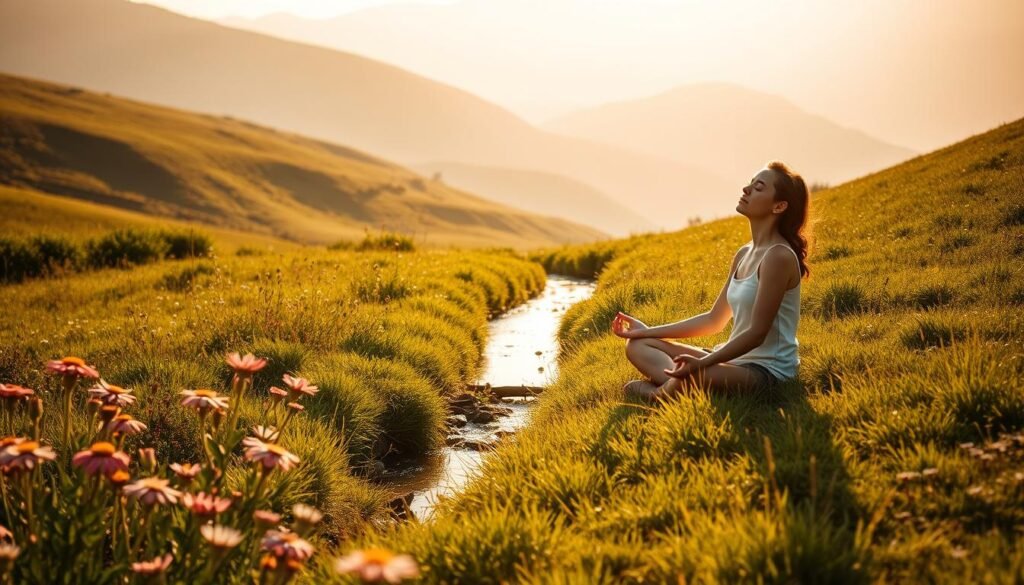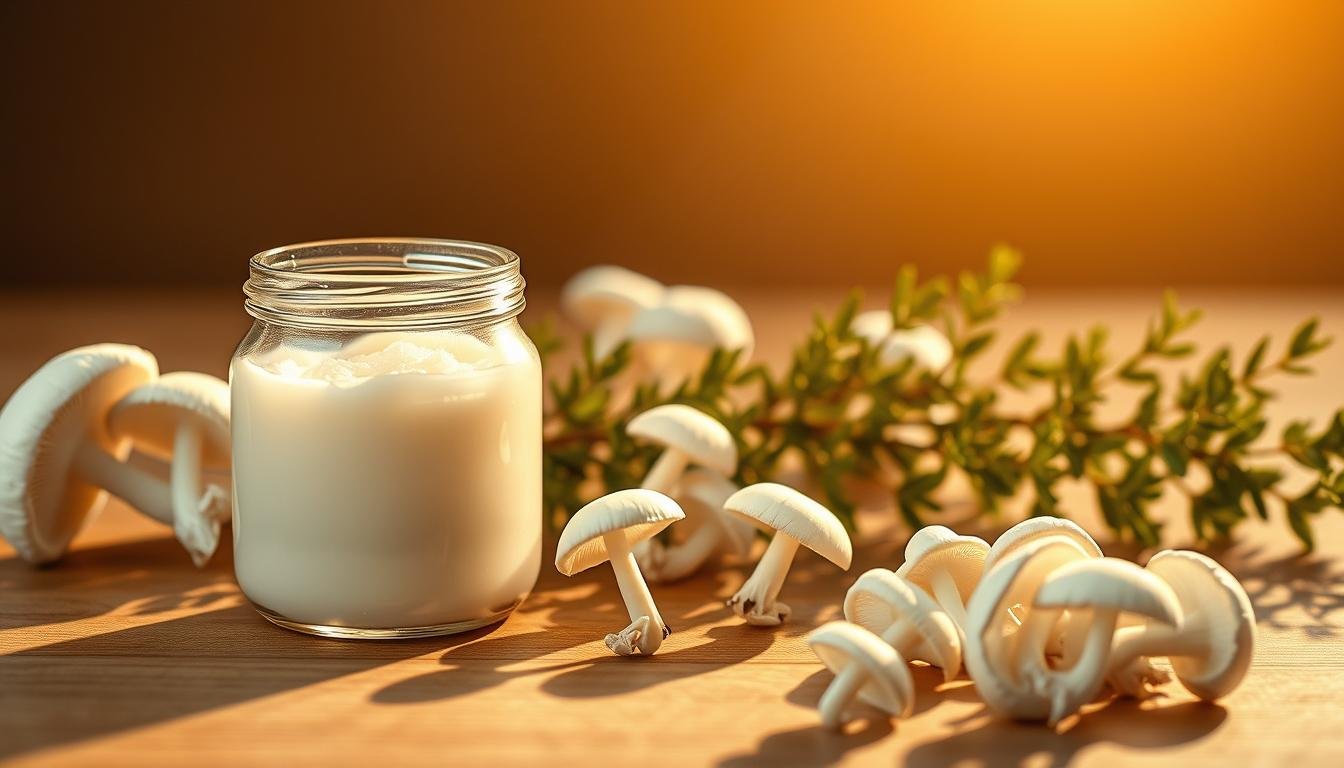Feeling overwhelmed by the planet’s state? You’re not alone. Climate change worries are causing a rise in eco-anxiety. This is a feeling of worry and fear about our environment’s future.
Nature-based relaxation methods can help ease this anxiety. By reconnecting with nature, people can find peace and tranquility in the chaos.
Looking into how human well-being and nature are connected can offer insights. This article will explore how nature-based strategies can reduce environmental fear.
Key Takeaways
- Nature-based relaxation methods can alleviate eco-anxiety.
- Reconnecting with nature promotes peace and tranquility.
- Understanding the human-nature connection is crucial for managing eco-anxiety.
- Nature-based strategies offer a promising approach to mitigating environmental fear.
- Embracing natural environments can improve overall well-being.
Understanding Eco-Anxiety and Its Impact
The world is facing climate change, leading to eco-anxiety. Eco-anxiety is the fear and worry about the environmental crisis and its effects.
What is Eco-Anxiety?
Eco-anxiety is feeling worried, scared, and hopeless about the future of our planet. It’s more than just caring about the environment. It’s a strong emotional reaction that can change how we live every day.
Symptoms of Eco-Anxiety
People show eco-anxiety in different ways. Some common signs include:
- Feeling hopeless about the future
- Having trouble sleeping because of environmental worries
- Staying away from news or social media about the environment
- Physical symptoms like headaches or stomach problems from stress
Spotting these signs is the first step to dealing with eco-anxiety.
Why it Matters for Mental Health
Eco-anxiety is important for mental health because it can cause more stress, anxiety, and depression. It’s key to understand and tackle eco-anxiety to keep our mental health strong despite environmental challenges.
The mental health benefits of nature are vital in fighting eco-anxiety. Being in nature can calm us, make us feel less alone, and connect us to the world.
Looking into eco-anxiety solutions that use nature can help people deal with their environmental fears. This not only helps our mental health but also strengthens our bond with nature.
The Role of Nature in Healing
As the world faces environmental stress, nature’s role in healing is key. Nature therapy, which uses natural settings to boost mental health, is growing in popularity. It helps us find calm in a busy world.
Nature deeply affects our mental health. Studies show it can lessen anxiety and depression symptoms. Nature’s benefits are both mental and physical.
Scientific Benefits of Nature for Mental Well-Being
Research has shown nature’s positive effects on mental health. Being in nature can lower stress hormones and heart rate. It also boosts our immune system and mood.
“Nature is not just a backdrop for human existence; it is an integral part of our well-being. By reconnecting with nature, we can begin to heal from the stresses of modern life.”
A study in the Journal of Environmental Psychology found nature improves our thinking. It boosts memory and creativity. Here are some key findings on nature’s mental health benefits.
| Benefit | Description | Impact |
|---|---|---|
| Reduced Stress | Lower cortisol levels and blood pressure | Improved mental health |
| Improved Mood | Increased serotonin levels | Reduced symptoms of depression |
| Enhanced Cognitive Function | Improved memory and creativity | Better problem-solving skills |
Connection Between Nature and Stress Relief
Nature and stress relief are closely linked. Activities like walking in the woods or gardening can reduce stress. Nature’s calming effects come from lowering cortisol and promoting relaxation.
Nature therapy, or ecotherapy, is a form of therapy in natural settings. It’s effective in reducing eco-anxiety by fostering a connection with nature.
In conclusion, nature plays a vital role in healing and stress relief. By embracing nature, we can significantly improve our mental health and reduce environmental stress.
Nature Therapy: An Overview
Nature therapy uses nature’s healing powers for mental health. It’s becoming more popular for tackling eco-anxiety and boosting well-being.
What is Nature Therapy?
Nature therapy, or ecotherapy, means doing outdoor activities in nature to better mental health. It includes practices that help people feel calm and less stressed by connecting with nature.
Nature therapy believes humans naturally love nature. Being in nature can greatly improve our mental health.
Different Approaches to Nature Therapy
There are many ways to practice nature therapy, each with its own benefits. Some common ones are:
- Forest bathing: A Japanese practice of soaking in forest vibes.
- Gardening: Gardening helps relax and feel accomplished.
- Nature walks: Walking in nature clears the mind and lowers stress.
These methods can be adjusted to fit what each person likes. This makes nature therapy flexible and easy to access.
How Nature Therapy Works
Nature therapy uses nature’s calm to reduce stress and anxiety. Studies show it lowers cortisol, boosts mood, and sharpens the mind.
| Benefits of Nature Therapy | Description |
|---|---|
| Reduces Stress | Nature’s calm reduces stress levels. |
| Improves Mood | Nature boosts mood and fights depression. |
| Enhances Cognitive Function | Nature improves focus and creativity. |
Nature therapy benefits not just individuals but also communities. It promotes a healthier human-nature relationship through eco-friendly stress relief.
Immersive Nature Experiences
Nature has many healing powers. Forest bathing and nature walks help us find mental peace. These activities are known to lower stress, boost mood, and improve our overall health.
Forest Bathing: A Japanese Tradition
Forest bathing, or Shinrin-yoku, is a Japanese tradition. It involves spending time in the forest to boost health. It’s not just a walk but a deep connection with nature through all senses.
“The forest is the physician of the soul.” This old saying shows how forests can heal us. By slowing down and enjoying the forest, we can lower stress, blood pressure, and boost our immune system.
Benefits of Nature Walks for Reducing Stress
Nature walks are great for reducing stress. Unlike city walks, they offer a peaceful setting. The gentle exercise and natural views can lift our mood and lessen anxiety and depression.
“In every walk with nature, one receives far more than he seeks.” – John Muir
Regular nature walks can also improve mindfulness. They help us stay in the moment and forget past or future worries. This mindfulness in nature brings calm and well-being, helping our mental health.
By adding nature experiences to our lives, we can build a healthier bond with nature. Whether through forest bathing or walks, connecting with nature offers deep and wide-ranging benefits.
Gardening as a Form of Therapy
Gardening is becoming more popular as a way to deal with environmental stress. It helps people feel calm and happy. This is especially true for those worried about the planet.
Therapeutic Benefits
Gardening has many benefits for mental health. It can lower stress, improve mood, and help the mind stay sharp. Plus, it’s good exercise, which is great for the body and mind.
- Stress Reduction: Taking care of plants and being outdoors calms the mind.
- Mood Improvement: Being in natural light and seeing plants grow can make you feel better.
- Cognitive Function: Gardening needs planning and solving problems, which keeps the mind active.
Starting Your Healing Garden
To start a healing garden, pick a spot that gets enough sunlight and is easy to get to. Choose plants that are simple to care for and good for your mental health, like lavender or chamomile.
- Assess Your Space: Check how much sunlight and space you have.
- Select Appropriate Plants: Pick plants that are calming or easy to care for.
- Start Small: Begin with a few plants and grow your garden as you get more comfortable.
By gardening, people can take action against eco-anxiety. They use gardening as a way to connect with nature and improve their mental health.
Mindfulness and Nature
Mindfulness in nature is more than a practice; it’s a way to find peace and strength against eco-anxiety. It combines mindfulness with the natural world. This helps people feel more connected and calm.
Practicing Mindfulness in Natural Settings
When you practice mindfulness in nature, you focus on the present moment. Notice the sights, sounds, and smells around you. You might see the colors and textures of plants, hear birds singing, or smell the earth.
To begin, find a quiet spot in a park or garden. Sit comfortably and close your eyes. Take slow, deep breaths and dive into the natural world. When thoughts come up, acknowledge them and come back to the present.

Incorporating Meditation in Nature
Adding meditation to your nature time can make it even more beneficial. Meditation in nature uses the outdoors as a focus for meditation. You might look at a tree or rock, or just watch the world around you.
| Benefits | Techniques |
|---|---|
| Reduces stress and anxiety | Focus on natural elements |
| Improves mental clarity | Mindful walking |
| Enhances mood | Breathing exercises |
By making these practices part of your daily life, you can grow stronger and appreciate nature more. As you practice mindfulness and meditation outdoors, you’ll find it easier to deal with eco-anxiety.
Community and Group Activities
Nature-based group activities mix social fun with a love for the environment. They help fight eco-anxiety. People gain mental health boosts and grow closer to nature.
Benefits of Group Nature Activities
Group nature activities offer many perks for those with eco-anxiety. Key benefits include:
- Stronger social bonds and a community feel
- More chances to use eco-friendly stress relief techniques
- Deeper nature appreciation from shared experiences
- Better mental health through nature immersion for mental wellness
These benefits are not just good for the mind. They also help build a greener, more aware community.
Starting or Joining Nature Therapy Groups
Looking to join or start a nature group? Here’s what to do:
- Look for local groups or organizations that focus on nature therapy or eco-friendly activities.
- Connect with others to start a new group.
- Find parks or natural spots for group activities.
- Plan activities like guided walks or conservation projects that promote nature immersion for mental wellness.
By following these steps, you can join a caring community. One that values both mental health and the environment.
Eco-Anxiety Solutions for Urban Dwellers
Urban dwellers can reduce eco-anxiety by using local green spaces and making indoor nature areas. As cities grow, it’s key for residents to connect with nature.
Finding Green Spaces in Cities
In urban areas, green spaces can be found or made. Urban parks and community gardens are great places to start. They offer a calm break from city life and chances to meet others.
To find green spaces in your city, you can:
- Use online directories or apps that map out local parks and gardens.
- Join local community groups focused on environmental conservation.
- Participate in urban greening initiatives.
Here’s a comparison of different types of green spaces and their benefits:
| Type of Green Space | Benefits |
|---|---|
| Urban Parks | Provides recreational areas, reduces urban heat island effect. |
| Community Gardens | Fosters community engagement, offers green therapy. |
| Green Roofs | Insulates buildings, creates habitats for wildlife. |
Creating Indoor Nature Spaces
On days when going outside is hard, indoor nature spaces can be a comfort. Indoor plants are not just pretty; they clean the air and boost mental health.
To create an indoor nature space:
- Select low-maintenance plants like succulents or air plants.
- Use natural elements such as wood or stone in your decor.
- Consider installing a small indoor fountain for a calming water feature.

By using these strategies, urban dwellers can manage eco-anxiety and help make cities more sustainable.
Expressing Your Eco-Anxiety Creatively
Using creativity can turn eco-anxiety into a positive force. It offers a way to deal with environmental worries. It also helps connect with nature and boosts mental health.
Art and Craft Projects Inspired by Nature
Art and craft projects inspired by nature can help with eco-anxiety. Activities like painting landscapes or making collages from leaves can express feelings. They help connect with nature.
These activities provide an emotional outlet and a sense of achievement. They help shift focus from eco-anxiety, improving mental health.
- Painting or drawing natural scenes
- Creating sculptures from natural materials
- Photography walks in nature
Writing and Journaling About Your Experiences
Writing and journaling are great for dealing with eco-anxiety. They help clarify thoughts and feelings. Reflective writing can also spot patterns and triggers.
Journaling about nature experiences can enhance benefits. Writing down observations or insights can deepen connection with nature. It promotes calm and well-being.
Tips for Effective Journaling:
- Set aside a dedicated time and space for journaling
- Be honest and authentic in your writing
- Explore different writing styles, such as poetry or stream-of-consciousness
Through art, writing, or other self-expression, we can manage eco-anxiety. Creativity and nature can build resilience and improve well-being.
Resources for Further Exploration
If you want to learn more about nature therapy and its effects on eco-anxiety, there are many resources. These can help you understand how to manage environmental stress better. They offer a holistic way to deal with it.
Recommended Literature
Books and guides can give you a deeper look into nature therapy. “The Nature Fix” by Florence Williams and “How to Do Nothing” by Jenny Odell are great examples. They show how nature, mental health, and the environment are connected.
These books can be a starting point. They help you understand nature therapy and how to use it in your life.
Online Support and Communities
Online communities and support groups are also great resources. They focus on nature therapy and eco-anxiety. Websites like the Nature Therapy Institute and forums for environmental mental health offer support and connections.
Being part of these communities can help you on your healing journey. It connects you with others who share your experiences and goals.



